I really love to travel, I try to visit a new country at every opportunity, for the last four or five years all the stories of my vacation abroad are connected with Germany, the reason is my friends who moved to Germany, who settled in different regions of Germany in search of a better life.
It has become a trend around me when people close to me go or try to go to different developed countries, their main motive is to get better opportunities and quality of life, and the term of departure is indefinite or permanent - Anita, 27 years old: "I went abroad because life in Georgia every day is a struggle for self-preservation, there are social, economic and mental factors.I don’t want to spend my whole life fighting for survival, I want to enjoy life and be in an environment where I can develop, learn, have fun, etc.”
The list of long-term top reasons for leaving the country, cited as environmental ones, is long and includes mostly socio-economic factors: high cost of food and basic necessities, high real estate prices, low incomes, and so on. ., the feeling of hopelessness created in the country is important. Lack of access to relevant services is also related to the unstable atmosphere and the general geopolitical situation.
Due to the urgency of the problem, the ACT team decided to study the attitude of the population towards migration, their experience, as well as collect official information related to this issue, which we share with you, readers.
To see the overall picture of migration, we reviewed the official data obtained by the National Statistical Service of Georgia. According to the National Statistical Service of Georgia, 125,269 people emigrated from Georgia in 2022, it should be noted that most of them - 80.5% (100,802 people) were citizens of Georgia. The research team contacted Sakstat to find out for what purpose, for what type of work and to which countries the population emigrated from Georgia in 2022, but this information was not available. As for the level of immigration, according to the National Statistical Service of Georgia, the number of immigrants in 2022 amounted to 179,778 people, among them the share of Georgian citizens was 30.3% (54,405 people).
How to explain the positive balance of migration?
Although the number of Georgian emigrants exceeded the number of Georgian immigrants by 46,397, in 2022 the migration balance was positive, with 54,509 more citizens entering the country than leaving. The number of immigrants who arrived in Georgia from the Russian Federation in 2022 exceeds the number of immigrants from all other countries and amounts to 62,304 citizens. The number of people who migrated from Ukraine is high - 20,716 and from Belarus - 13,316. In total, in 2022, only the number of Georgian emigrants exceeded the number of immigrants, which suggests a positive migration balance due to the influx of citizens of other countries. Among them, the number of citizens of the Russian Federation is at least three times higher than the number of immigrants from all other countries.
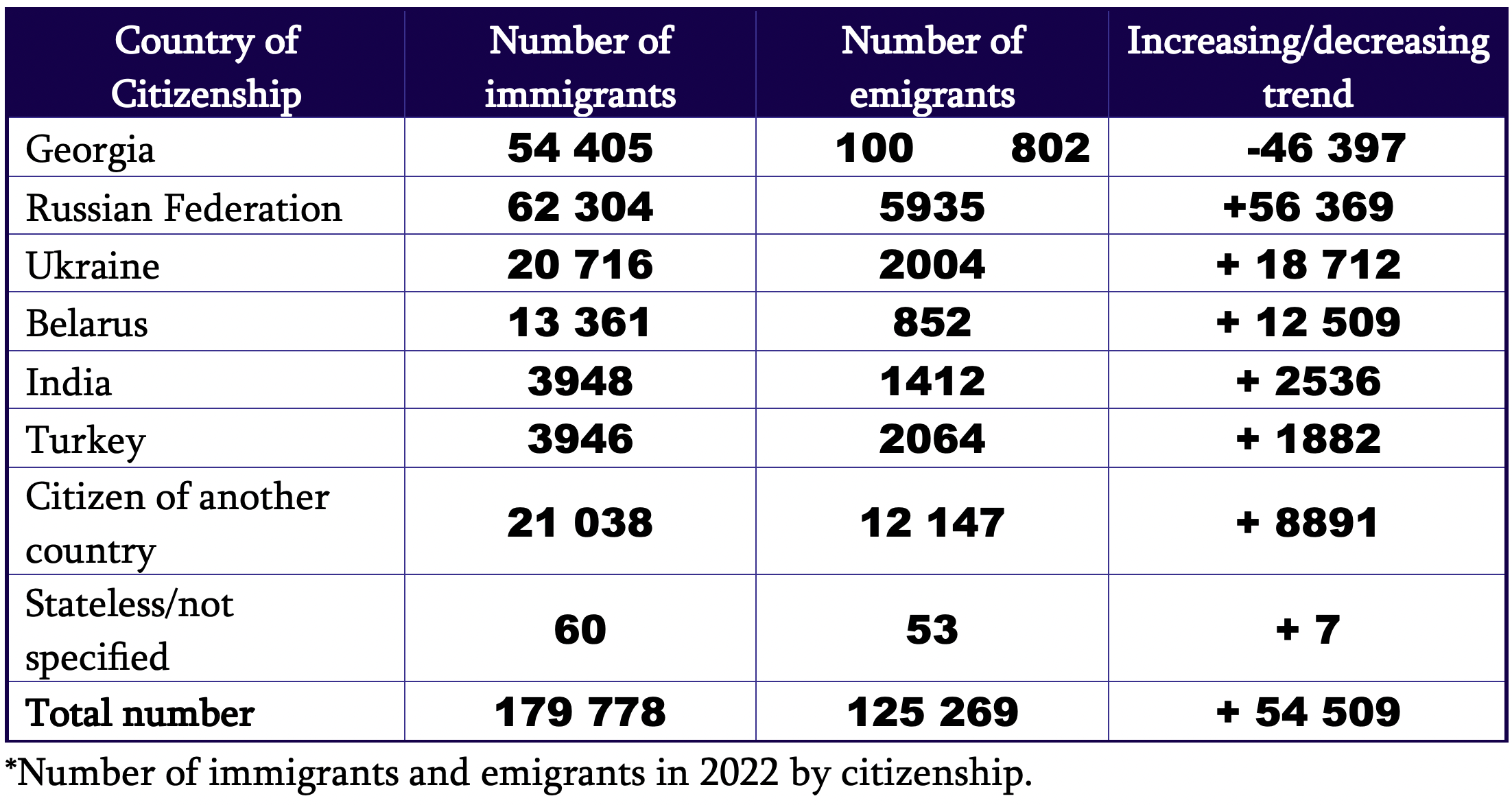
Green card
With a positive growing migration balance, the population of Georgia is looking for different ways to leave the country. One of the most common forms of emigration from Georgia is participation in the drawing of a green card. There has been an increase in the number of people around me who have completed the green card or are considering moving to the United States of America as one of their alternative plans for the future. We were interested in the number of participants and green card holders from Georgia in the green card draw. According to the US State Department, from 2011 to 2021, the number of Georgians trying to get a green card almost tripled, from 39,253 to 112,464. In 2022, 2,071 Georgian citizens won a green card, and from 2002 to 2022, that figure reached 18,737. Eka, 43 years old: “I applied for a Green Card several times with my husband, I want to go to America for employment.” I have a job in Georgia. I also want to live and work in my country, but I feel unstable and insecure both in front of myself and in front of my husband. The reason for our departure is low income and unstable work. The backwardness of the country and the lack of future, development and progress.
Mood and plans for the future of the population
My sentiments about emigration coincided with the opinion of the majority of the population, the results of the EITI survey showed that the majority of the population of Georgia - 83% share the opinion that over the past 3 years the number of people who left Georgia to live abroad for a long time or permanently has increased. 9 out of 10 respondents believe that the main purpose of leaving is to find a job. As for the reasons for leaving, according to citizens, the outflow from the country is mainly related to social and economic factors: low pensions and incomes - 69%, lack of jobs - 62 %, expensive goods and services (food, clothing, etc.) - 42%. Almost one-fifth of the population - 18% - emphasizes the availability and low quality of health care, for 16% the main reason for emigration is a sense of social hopelessness.
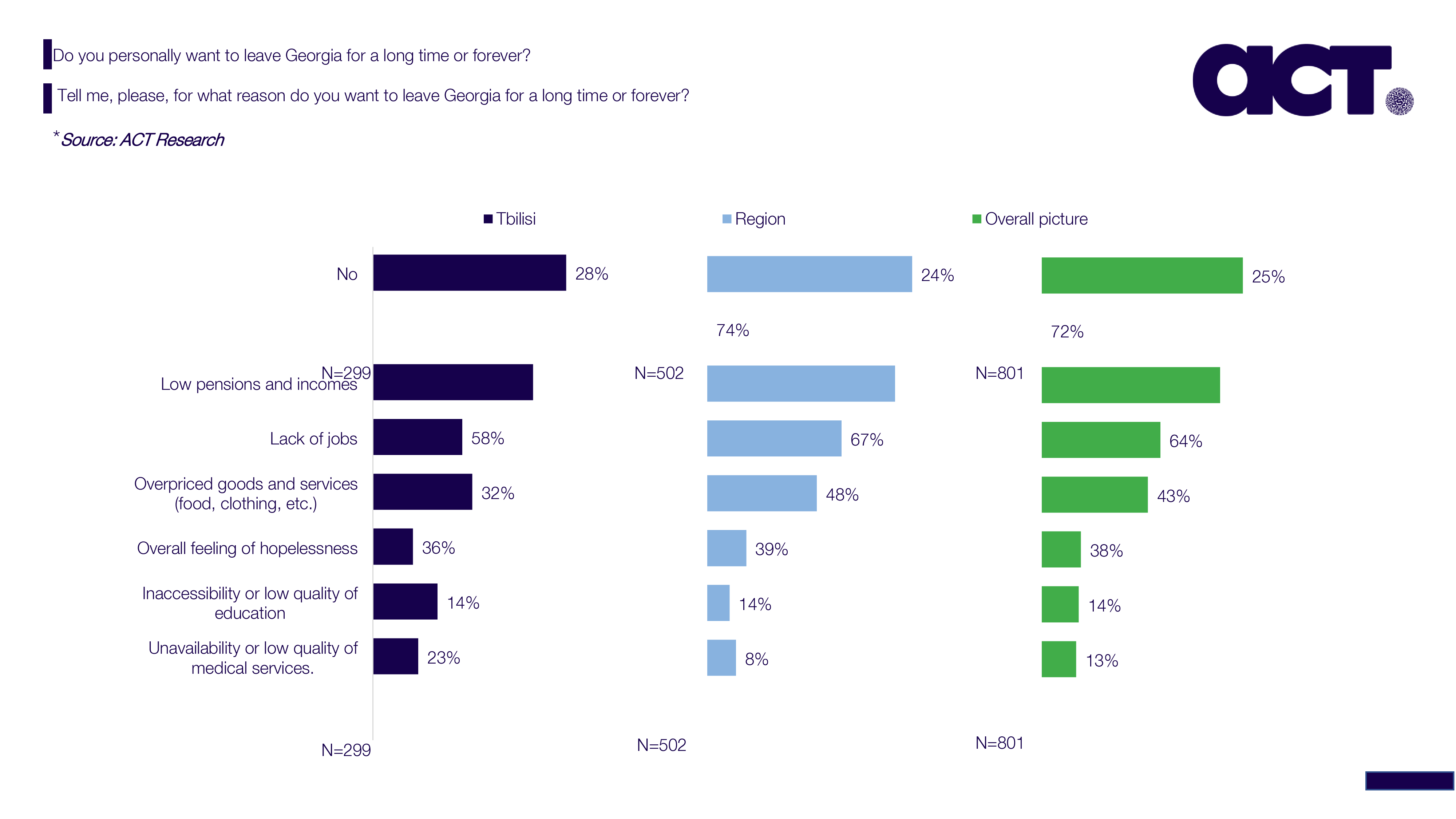
A real experience of going abroad
As for the actual experience of respondents traveling abroad, over the past 3 years, every second respondent-citizen or a member of his family, or a respondent with family members, went abroad. It should be noted that this experience is more common in Tbilisi - 56% than in the regions - 41%. More than half of the respondents and/or their family members - 51% went abroad to work, a quarter of the respondents - 25% for vacation. 43% of those who left the capital went on vacation, and the bulk of the region's population - 61% - went to work.
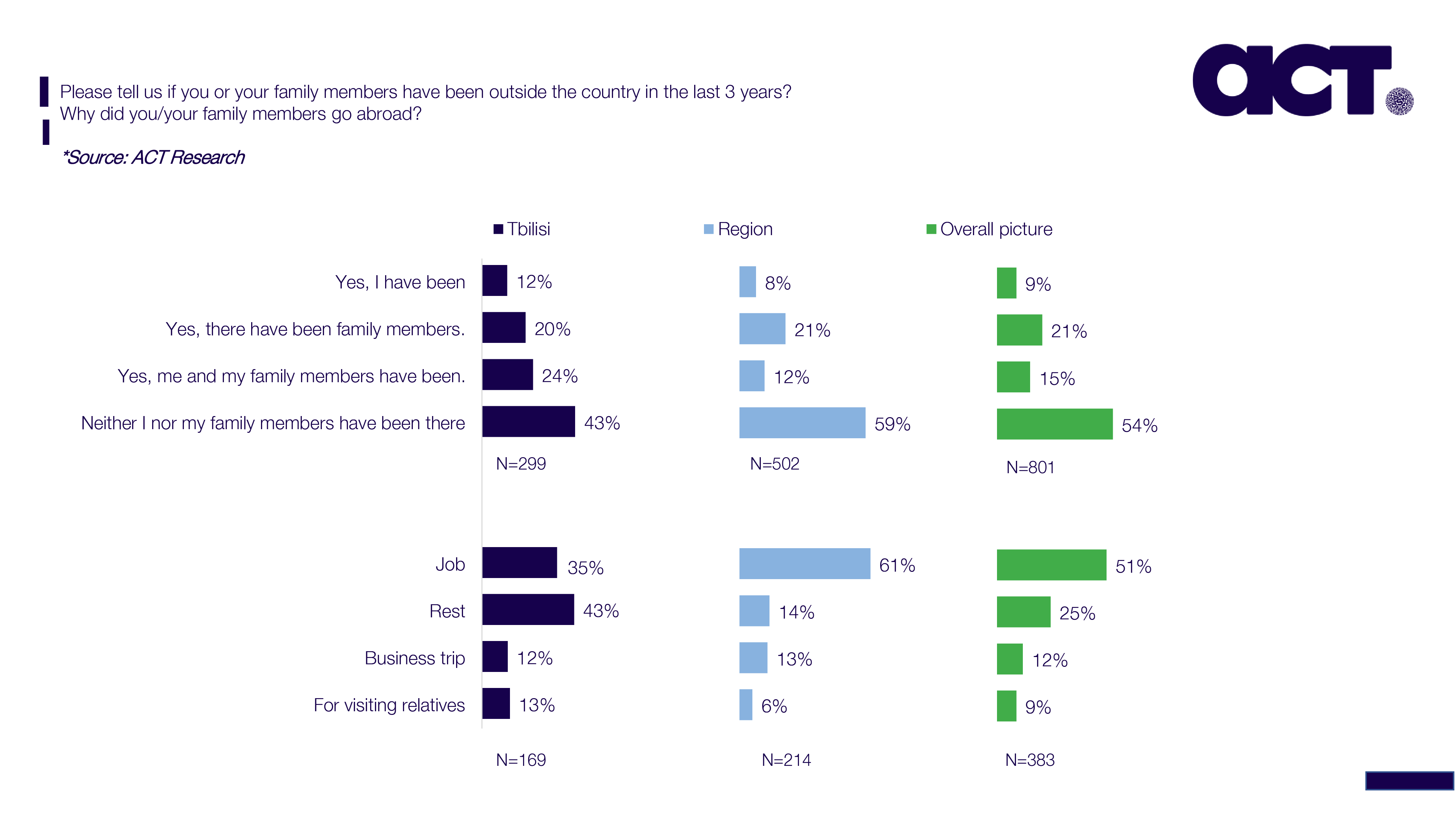
Future plans and expectations
Recently, I have been considering going abroad as one of my future plans, for me it is more of a “forced alternative” than a real desire. It turned out that a quarter of the respondents - 25% also have a desire to leave for a long time or forever. The main reasons why respondents want to leave for a long time or permanently are still related to socio-economic factors, a relatively small number of respondents named such factors as a sense of hopelessness in society - 14%, inaccessibility of education or its low level. quality - 13%, inaccessibility of medical services or low quality - 12%, it is worth noting that access to education and medical services is relevant for most of the population of Tbilisi.

Due to the increase in immigration of foreign citizens, my Georgian friends/acquaintances are leaving for developed countries in search of a better life, mainly to Germany or the United States of America. According to the ACT study, one fifth of the respondents who want to leave the country for a long time or permanently, mainly go to Germany (20%) and the United States of America (20%), it should be noted that the number of people who want to go to Germany in the region is relatively large and amounts to 23 %, and a quarter of respondents from the capital - 30% want to go to the United States of America. Every third respondent (28%) finds it difficult to say where he wants to go for a long time or forever.
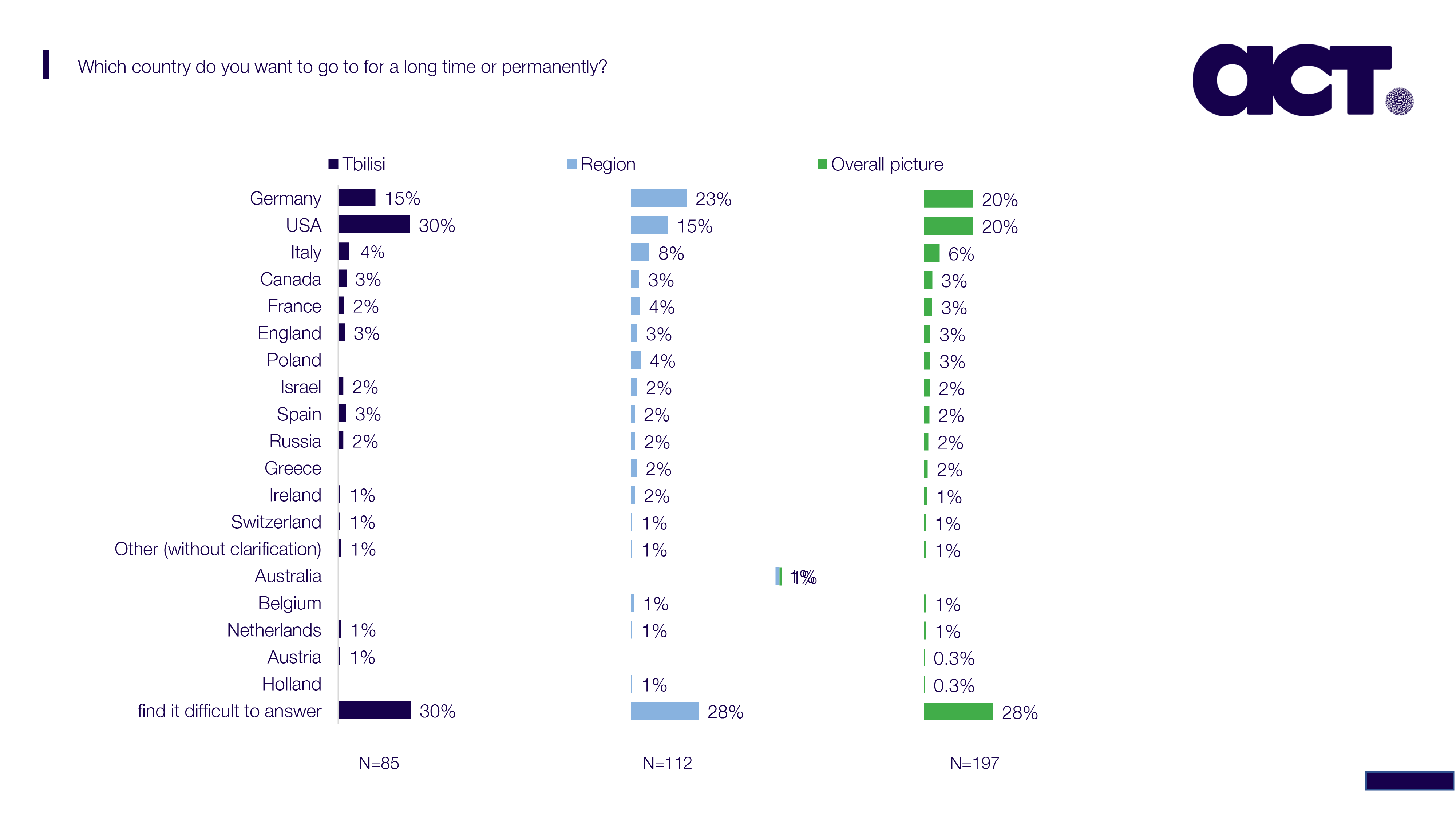
As for the prospects for the return of the Georgian population who left for emigration, every fourth (39%) respondent believes that the population who left the country will never return, this opinion is shared by half of the population of Tbilisi - 49%.
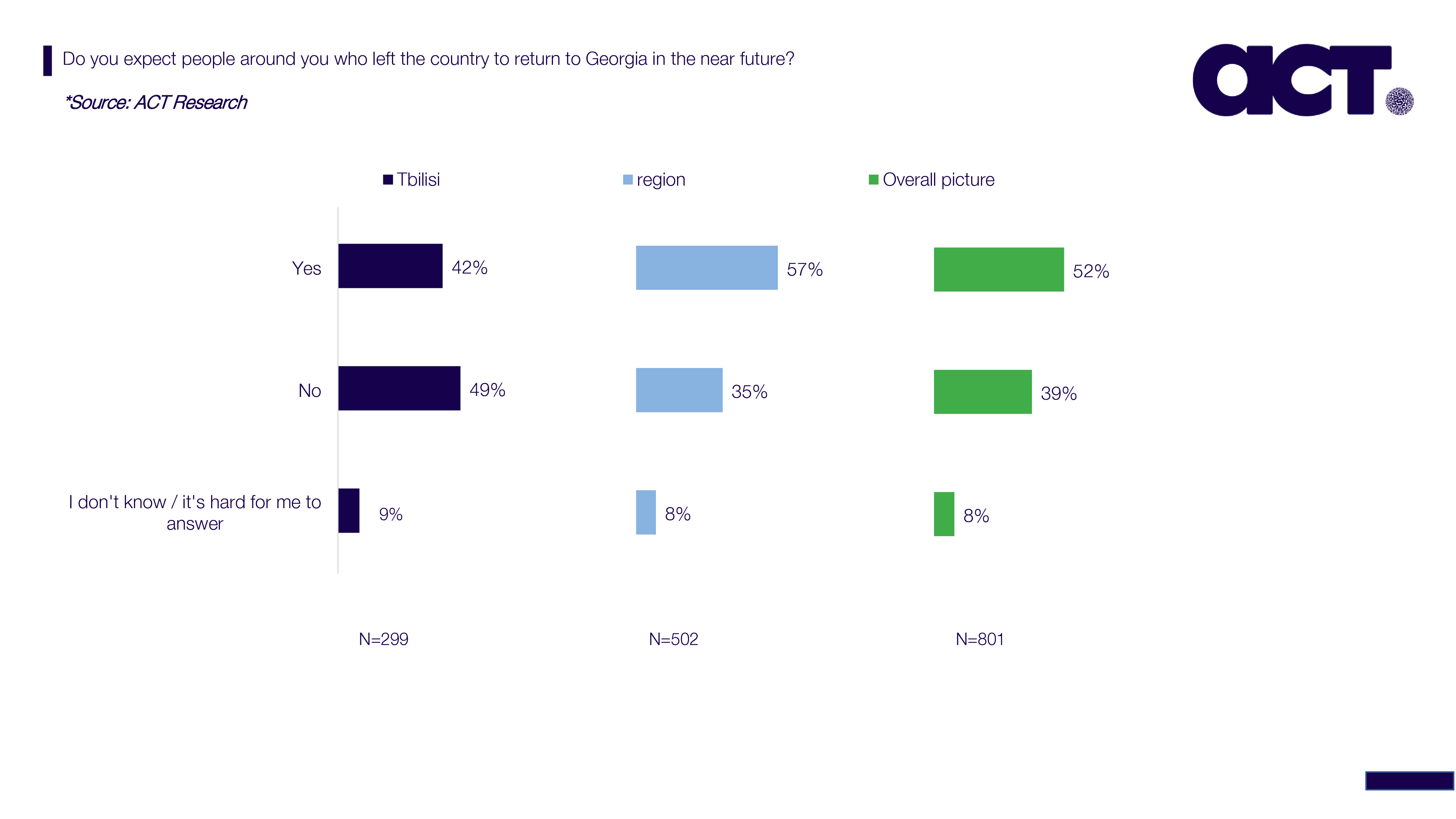
Despite the problems in our country, my favorite part of every trip is returning to Georgia, I often wish that the conditions, the environment would make me want to return to Georgia, and not very subjective reasons, although I am also aware that we are creating such environment together, of course, first of all by the mandate of trust that we give to those who are responsible for creating this environment, and on the other hand, by active civic activity, with the help of which we contribute to maintaining this responsibility.
Research methodology: ACT conducted a population survey on issues related to migration in June 2023. The study involved 801 randomly selected citizens of Georgia aged 18+. The average statistical error of the data is 3.5%. The method used is a telephone survey.
According to the Sakstat methodology:
Emigrant
A person who left Georgia and stayed in the territory of another state for at least 6 months (183 days) during the last 12 months. This number of days can be cumulative over several trips abroad.
In addition, for this person who left the country, Georgia must have been the country of permanent residence (i.e., he must have spent at least 6 months in Georgia in the previous 12 months before leaving the country).
Iimmigrant
A person who crossed the border of Georgia and stayed in the territory of Georgia for at least 6 months during the last 12 months. In this case, it is also possible that this is the total number for several trips. In addition, Georgia was not his country of permanent residence (i.e., he had spent at least 6 months outside of Georgia in the previous 12 months).
Migration balance - the ratio of people leaving the country and entering the country.
Sources:
1. https://publika.ge/2022-wels-saqartvelos-100-000-ze-meti-moqalaqe-wavida-emigraciashi-saqstati/
2. https://www.geostat.ge/ka/modules/categories/322/migratsia






